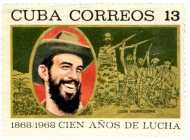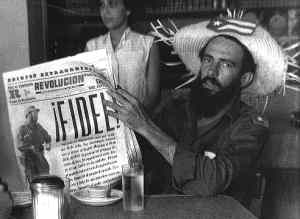
Camilo Cienfuegos
By J.A. Sierra
"Camilo Cienfuegos was the real hero of the day. He was
the youngest, the most handsome. He was loyal to Fidel, but he followed Che and
other Marxists."
"I think it was simply his destiny to die young."
Carlos Franqui from "FAMILY PORTRAIT WITH FIDEL"

Shortly before the defeat of Batista by revolutionary rebel forces in 1958, four men could be said to embody the spirit of the revolution to the Cuban population. Camilo Cienfuegos was one of those men. (The others were the Castro brothers, and Ernesto “Che” Guevara.)
As a young man of twenty-three years, Camilo joined a student demonstration in honor of Cuban folk hero Antonio Maceo. Marching through the street, the crowd was fired upon by Batista’s military police and was attacked by thugs with steel bars wrapped in newspapers.
Camilo was hit in the leg by a bullet, and he recalls his experience at the hospital, “they carried me to the student clinic,” he recalls, “where I experienced one of the greatest emotions of my life, when more than a hundred people gathered there in the entrance broke into cheers and applause when they carried me up, and I felt such an emotion, I felt about to cry, and I yelled out, ‘Viva Cuba!’ I was most sure then that, whatever the cost, Cuba had to be free.”
“In my way of thinking,” he wrote later, there is only one dignified road toward ending the present situation… to follow the cause of Fidel.”
"Camilo gave the impression he never thought about death, but I think he had a premonition he would die young."
Camilo rose from an undisciplined fighter to a brilliant, disciplined captain of the point platoon, the most dangerous position in the war. He commanded a 700-man force of the Rebel Army, furiously attacking government troops in Camagüey and Las Villas.
Camilo, who was not a communist, became immensely popular among Cubans, but not quite as popular as Fidel Castro.
Less than a year after their victory, on October 28 1959, Camilo’s Cesna-310 mysteriously disappeared over the ocean during a night flight from Camagüey to Havana. An immediate search was called, but the plane was never found.

Over the years, some have charged that Camilo was "probably killed by Castro," but historians seem to agree that Camilo's death is more likely to have been an accident, and not the result of foul play. [Carlos Franqui's book Camilo Cienfuegos is said to address contradictions in the official story, and I'm still hoping to find a copy-JAS]
In the last public speech before his disappearance, Camilo declared, "Even if it brings the sky down on our heads, agrarian reform is on!" showing his full agreement with The Revolution.
"Camilo gave the impression he never thought about death," said Haydée Santamaría to Carlos Franqui for his book The Twelve, "but I think he had a premonition he would die young."
"I constantly imagine Camilo's reactions to things," added Celia Sánchez. "For me, he is still living."
On October 28 the children of Cuba throw flowers into the sea. "A flower for Camilo," they say.
Photo: Camilo photographed by Osvaldo Salas
From the book
"Fidel's Cuba, A Revolution in Pictures"
By Osvaldo Salas and Roberto
Salas
Beyond Words Publishing, Inc.
Related:
Che
Guevara | The landing of the Granma
| Contents: Before the Revolution
Return to 1959